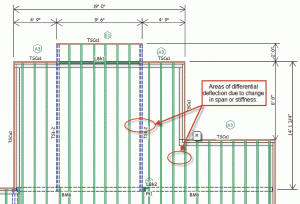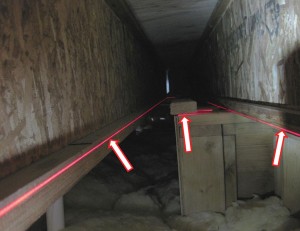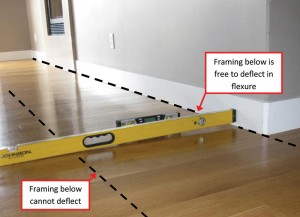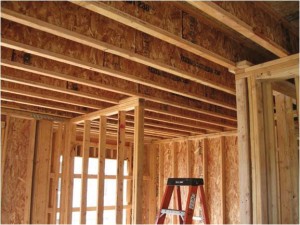There is an important design consideration for wood floor framing that is not likely to be found in building codes or design standards – differential deflection. This issue is often overlooked, but can lead to significant performance problems. Differential deflection, as described here, is the change in elevation from one framing member to the adjacent member. Differential deflection may escape consideration. Building code requirements and design standards for deflection typically pertain only to the deflection along the span length of an individual member. Problems related to differential deflection can arise when one long span member deflects in flexure, within building code limits, while the adjacent member does not, often due to different support conditions or stiffness (Figure 1).

Figure 1: Areas with potential for differential deflection due to change in span or stiffness of adjacent members.
Relatively longer spans and higher loads have the potential to make differential deflection problems in floors more pronounced. The 2012 International Building Code (IBC), Section 1604.3, requires floor members supporting dead and live loads to not exceed an L/240 deflection limit. For example, for a 30-foot span (L), deflection of up to 1.5 inches in a single floor member would be permissible per the IBC. But if, in this example, the adjacent floor framing member were 16 inches away and supported to prevent deflection, then a pronounced differential deflection might result. Let’s consider the issue with a few actual cases the authors are familiar with, in which differential deflection caused performance problems identified shortly after the new construction was completed.
Case Studies
Case 1–Residence
A large custom single-family wood frame home had wood I-joists spanning 22 feet under a living room and spaced at 16 inches on center. Near mid-span, a partition wall for the level below was built tight to the bottom flange of one of the floor joists such that mid-span deflection was prevented. Floor dead loads were relatively high in this case due to hydronic heating with a 1.5- inch thick Gyp-Crete topping and a stone tile floor above. The resulting differential deflection was around 1 inch vertical over 16 inches horizontal (Figure 2). The resulting performance problems included objectionable floor sloping as well as excessive stone tile cracking, which occurred due to the resultant differential deflection.

Figure 2: Wood I-joist on right bears on wall framing while the adjacent I-joist (left) spans 22 feet and is free to deflect under load. The laser level line (arrows) shows the I-joist on the left is roughly 1 inch lower than the adjacent one on the right.
Case 2–Multi-Unit Condominium
A condominium building was designed and constructed with an open grade-level floor for parking, with residential units above. The elevated floor above the open parking area was supported by wood floor trusses spanning 30 feet and spaced at 19.2 inches on center. The structural framing and column layout placed column supports near mid-span of some floor framing, while adjacent floor trusses 19.2 inches away were free to deflect over their 30-foot span. The floor trusses supported dead loads of about 20 pounds per square foot. The resulting long span deflections were as expected and within building code limits. The differential deflection between the non-deflecting floor framing and near mid-span of the 30-foot long spanning floor trusses created localized floor slopes in multiple condominium units. The resulting slope caused racking of interior partition walls, which led to gypsum wall board cracking and door operational issues.

Figure 3: Kitchen floor ridge and floor sloping toward wall. Dash lines represent framing direction below floor.
Case 3–Residence
Soon after the owners moved into their new home, they noticed that the kitchen floor was sagging near an adjacent hallway (Figure 3), which caused concern. Investigation revealed that the cause was due to the fact that a partition wall below prevented some of the wood I-joist floor framing from deflecting while the adjacent wood I-joists were free to deflect over their 17-foot span, creating the differential deflection and objectionable slope.
In Cases 1, 2 and 3, the floor framing was either designed to just meet code limits and/or construction errors had occurred in which loads were higher than anticipated in the original floor framing design. We observed that, in each of these example cases, the flexural design of the relatively long-span floor framing just met code limits.
Suggestions for Designers
Designers should be aware that differential deflection can lead to significant performance problems and even litigation. Therefore, identify where these issues may occur and consider the suggestions provided here to minimize the potential for differential deflection related problems.
Great rooms and kitchen areas may have long spans, higher loads due to floor finishes, and are often a focal area which has a higher owner expectation on floor performance. A great room may be a large open space, but it is likely that the support structure below does not match the same spans. There may be bearing walls (or non bearing walls) below, making the span of the joist variable from area to area.
When designing these focal areas, be aware of what load-bearing and non-load-bearing members may be above and below. The best design minimizes changes in spans, framing direction, or different member stiffness within the focal area.
Non bearing partition walls below can produce differential deflection if they are framed tight to the underside of the joist (a common practice for residential structures) compared to adjacent joists that have no walls (Figure 4). When walls are framed tight to the bottom of joists near mid-span, they act as a bearing support and prevent deflection. If non load bearing walls are in the focus area, details to properly gap the wall at the top should be included to prevent transferring of load and inadvertent “high” spots or “ridges” in the floor surface above.

Figure 4: In areas with non-load-bearing walls, consider gapping the wall to ensure all joists deflect equally.
Changes in framing direction, introduction of large stiff beams or additional loading such as center islands and counter tops may also contribute to unfavorable differential deflection. If these are unavoidable in the area of concern, adding members or changing spacing or stiffness of framing members may be prudent ways to avoid potential differential deflection problems. In some cases, the floor finish installation guidelines, for example those from the Dimension Stone Design Manual (DSDM), may require floors with increased stiffness. Increasing the stiffness of the floor framing in general helps minimize the potential for differential deflection. Additionally, guidelines in the DSDM or Tile Council of North America Handbook provide criteria on levelness of the subfloor. The levelness of the floor can extend parallel or perpendicular to the framing member, and differential deflection could create a levelness problem for certain floor finishes like stone or ceramic tile.
Conclusion
Because there are no defined guidelines, design checks for potential differential deflection is discretionary but often overlooked. Ultimately, differential deflection can be a nuance issue, and requires engineering judgment to minimize potential problems. Increasing the overall stiffness of the long span floor framing to reduce their deflection is an easy rule of thumb to minimize the potential for differential deflection-related problems.▪
